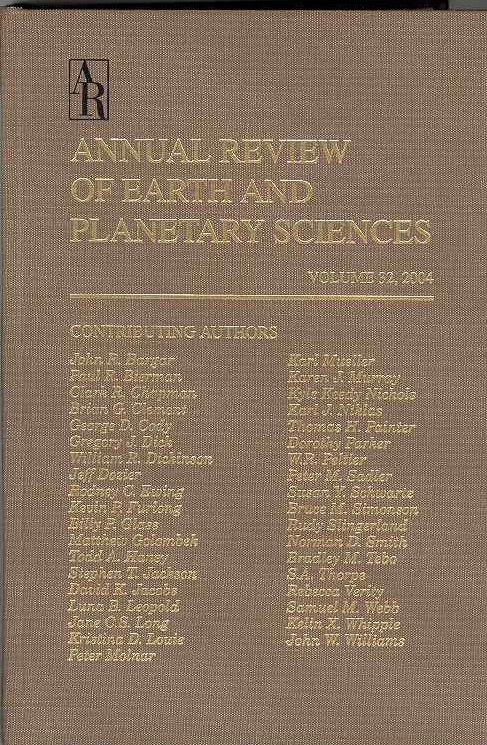新石器时代榴辉岩的成因及其地球动力学意义
IF 13
1区 地球科学
Q1 ASTRONOMY & ASTROPHYSICS
Annual Review of Earth and Planetary Sciences
Pub Date : 2023-02-15
DOI:10.1146/annurev-earth-031621-112904
引用次数: 2
摘要
金伯利岩携带的xenolithic榴辉岩,通常出现在克拉通或克拉通附近,长期以来被认为是前寒武纪俯冲海洋地壳的残余物,经过部分熔融产生了类似于太古宙大陆地壳的花岗岩。部分榴辉化洋壳在克拉通岩石圈内侵位,大部分洋壳在对流地幔内深俯冲形成岩性和地球化学非均质。如果我们承认绝大多数xenolithic榴辉岩最初形成于地球表面,那么它们的地球动力学意义包括四种构造环境:(a)扩张脊,其前体由对流地幔的部分熔融和随后的熔融分异形成;(b)俯冲带,洋壳变质并与其他板块岩性相互作用;(c)克拉通地幔岩石圈,其中榴辉岩源在中太古代至古元古代侵位后发生了变化;(d)对流地幔,在克拉通岩石圈中未被捕获的绝大多数俯冲修饰的海洋地壳被再循环到对流地幔中。◆新石器时代榴辉岩是3.0 ~ 1.8 Ga洋壳的碎屑,标志着中太古宙以来强烈的俯冲构造。▪多种约束条件表明其成因为变分化的洋壳、俯冲变质作用和长时间的地幔居住。因此,Xenolithic榴辉岩允许研究与前寒武纪海洋地壳循环有关的深层地球化学循环。它们有助于限制软流圈的热和氧化还原演化,并有助于克拉通的物理性质和矿物禀赋。《地球与行星科学年鉴》第51卷的最终在线出版日期预计为2023年5月。修订后的估计数请参阅http://www.annualreviews.org/page/journal/pubdates。本文章由计算机程序翻译,如有差异,请以英文原文为准。
Petrogenesis and Geodynamic Significance of Xenolithic Eclogites
Kimberlite-borne xenolithic eclogites, typically occurring in or near cratons, have long been recognized as remnants of Precambrian subducted oceanic crust that have undergone partial melting to yield granitoids similar to the Archaean continental crust. While some eclogitized oceanic crust was emplaced into cratonic lithospheres, the majority was deeply subducted to form lithologic and geochemical heterogeneities in the convecting mantle. If we accept that most xenolithic eclogites originally formed at Earth's surface, then their geodynamic significance encompasses four tectonic environments: ( a) spreading ridges, where precursors formed by partial melting of convecting mantle and subsequent melt differentiation; ( b) subduction zones, where oceanic crust was metamorphosed and interacted with other slab lithologies; ( c) the cratonic mantle lithosphere, where the eclogite source was variably modified subsequent to emplacement in Mesoarchaean to Palaeoproterozoic time; and ( d) the convecting mantle, into which the vast majority of subduction-modified oceanic crust not captured in the cratonic lithosphere was recycled. ▪ Xenolithic eclogites are fragments of 3.0–1.8 Ga oceanic crust and signal robust subduction tectonics from the Mesoarchean. ▪ Multiple constraints indicate an origin as variably differentiated oceanic crust, subduction metamorphism, and prolonged mantle residence. ▪ Xenolithic eclogites thus permit investigation of deep geochemical cycles related to recycling of Precambrian oceanic crust. ▪ They help constrain asthenosphere thermal plus redox evolution and contribute to cratonic physical properties and mineral endowments. Expected final online publication date for the Annual Review of Earth and Planetary Sciences, Volume 51 is May 2023. Please see http://www.annualreviews.org/page/journal/pubdates for revised estimates.
求助全文
通过发布文献求助,成功后即可免费获取论文全文。
去求助
来源期刊

Annual Review of Earth and Planetary Sciences
地学天文-地球科学综合
CiteScore
25.10
自引率
0.00%
发文量
25
期刊介绍:
Since its establishment in 1973, the Annual Review of Earth and Planetary Sciences has been dedicated to providing comprehensive coverage of advancements in the field. This esteemed publication examines various aspects of earth and planetary sciences, encompassing climate, environment, geological hazards, planet formation, and the evolution of life. To ensure wider accessibility, the latest volume of the journal has transitioned from a gated model to open access through the Subscribe to Open program by Annual Reviews. Consequently, all articles published in this volume are now available under the Creative Commons Attribution (CC BY) license.
 求助内容:
求助内容: 应助结果提醒方式:
应助结果提醒方式:


